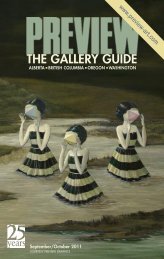Nov 2011 âJan 2012 - Preview
Nov 2011 âJan 2012 - Preview
Nov 2011 âJan 2012 - Preview
- No tags were found...
Create successful ePaper yourself
Turn your PDF publications into a flip-book with our unique Google optimized e-Paper software.
Conservator’s CornerBY NADINE POWERFINE ART CONSERVATOR, nadinepower@hotmail.comTo Line or Not to Line: Structural Remedies for Canvas PaintingsBefore treatment: large tears to the canvas on upper leftIn 2006, when Las Vegas hotel tycoon, Steve Wynn,famously put his elbow through Picasso’s Le Rêve, a collectivecringe rippled through the conservation world. It wasnot just the heartbreaking damage to a masterpiece thatmade the incident so horrendous, nor was it the fact that theaccident nullified Wynn’s deal to sell the work for $139 millionto Steven A. Cohen, but those who have repaired canvastears knew that the work involved in restoring the paintingwould certainly be difficult.In historic conservation processes, it would have oftenbeen necessary to line a canvas such as Le Rêve to repair thedamage. Lining is a centuries-old process that involves gluinga second fabric backing to a weakened or damaged canvasto provide structural support to a fragile painting. Traditional linings used animal-based glue paste orwax-resin mixtures to attach the fabric to the canvas, and a heated iron and/or a large press were then usedto flatten the two fabrics together. Although often very effective, the treatments were invasive, harsh, andoccasionally resulted in the flattening of impasto, impregnation of the paint with wax, or even shrinking ofthe original canvas.Still today, lining can be a necessary step in the preservationof a work of art and is often chosen by conservators when treatingvery old or badly damaged art works. The 20th-centurydevelopment of new adhesives and fabrics have improved thelining process considerably, making it a more controllable one.Advancements have reduced the amount of heat, moisture andpressure required, and have also increased the reversibility of alined painting. Repairs to the painting Still Life with Flowers byApril Banyack is an example where, although lining would havebeen an appropriate choice due to the severity of the tears, lessinvasive treatment methods were considered.Still Life with Flowers was torn in several places when itfell off the wall onto the back of a chair. Painted in 1954, the canvas was in relatively good conditionalthough some weakening around the tacking margins was noted.After surface cleaning and varnish removal, the tears were carefullyrewoven, using both the original fibres and canvas threadinserts secured with welding powder and a hot tacking iron. Tearmending, although often extremely time consuming, can be arewarding alternative to lining, and when properly executed, ispractically invisible when viewed from both the front and back.Because this painting was weak around its tacking edge, thedecision was also made to strip line the painting. Strip lining is aAfter treatment: detail of mended tear from the backBefore treatment: tears from the backtechnique that introduces adhesive and a backing fabric only aroundthe exterior edges of the work, where a canvas is often the weakest,providing the necessary support for restretching the canvas onto its stretcher bars. After the structural treatments,the painting was filled and retouched to replace lost paint around the tear areas and then varnished.Although lining would have been a faster method and certainly would have been an effective treatmentfor mending the tears, the concern for the integrity of the original canvas and the artwork as a historicobject influenced the decision to mend by reweaving.NEXT ISSUE: Modern Materials: The Restoration of two murals in the Simon Fraser University Theatre – Part I68 PREVIEW ■ NOVEMBER/DECEMBER/JANUARY <strong>2011</strong>/12
















